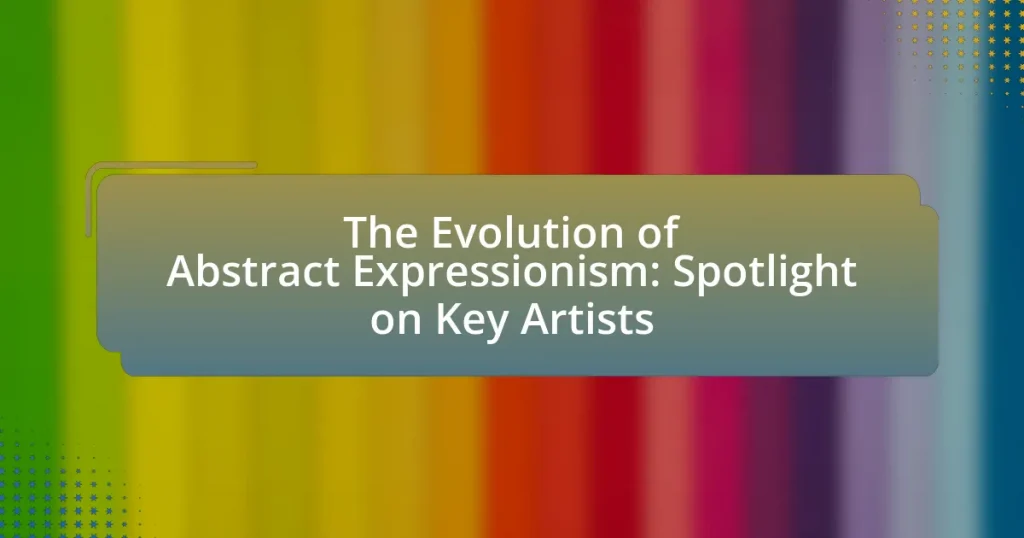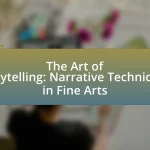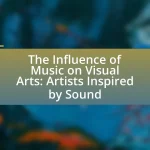Abstract Expressionism is a significant art movement that emerged in the United States during the 1940s and 1950s, characterized by spontaneous and subconscious creation, with a focus on emotional expression rather than physical representation. Key artists such as Jackson Pollock and Mark Rothko played pivotal roles in this movement, employing innovative techniques like drip painting and color field painting to convey deep emotional experiences. The article explores the historical and cultural factors that influenced Abstract Expressionism, its defining characteristics, and its impact on subsequent art movements, while highlighting the contributions of notable artists and the evolution of the movement over time. Additionally, it examines the legacy of Abstract Expressionism in contemporary art and the lessons that can be drawn from its development.
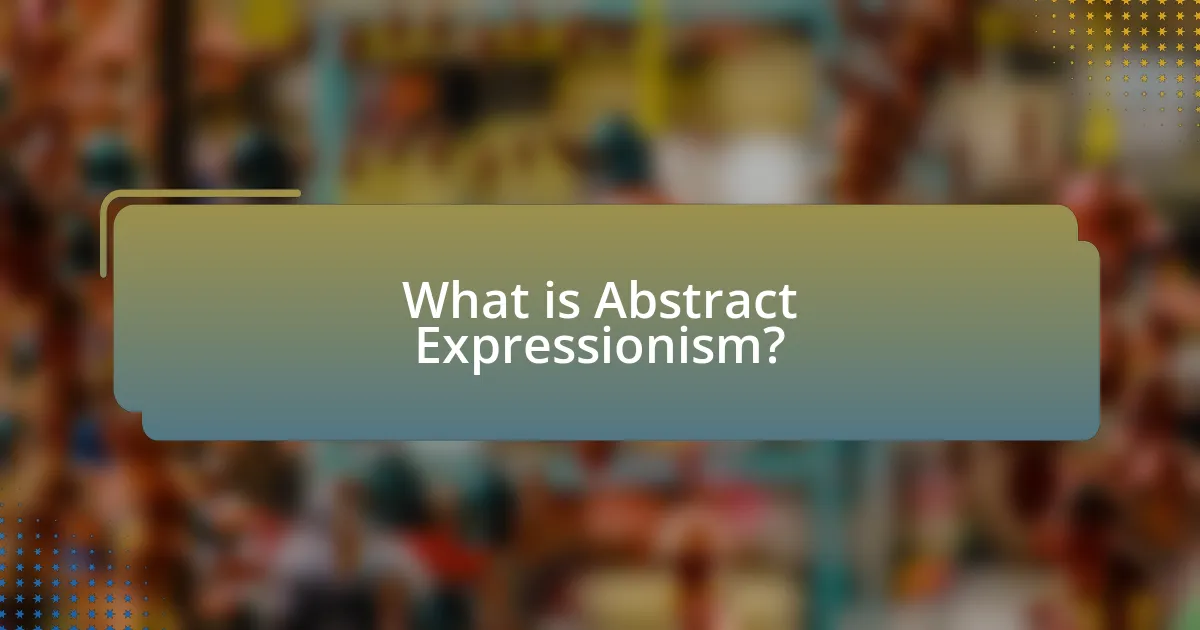
What is Abstract Expressionism?
Abstract Expressionism is an art movement that emerged in the United States in the 1940s and 1950s, characterized by spontaneous, automatic, or subconscious creation. This movement emphasizes the expression of emotional experience rather than physical reality, often utilizing large canvases and bold colors. Key figures such as Jackson Pollock and Mark Rothko exemplified this style through their innovative techniques, including Pollock’s drip painting method, which allowed for a dynamic interaction between the artist and the canvas. The movement played a crucial role in establishing New York City as a center for modern art, marking a significant shift from European influences to American artistic identity.
How did Abstract Expressionism emerge as an art movement?
Abstract Expressionism emerged as an art movement in the 1940s in New York City, primarily as a response to the trauma of World War II and the desire for individual expression. Artists sought to break away from traditional forms and techniques, emphasizing spontaneity, emotion, and the act of painting itself. Key figures such as Jackson Pollock and Mark Rothko played pivotal roles in this movement, utilizing innovative techniques like drip painting and color field painting to convey deep emotional experiences. The movement was also influenced by European modernism, particularly Surrealism and Dada, which encouraged artists to explore the subconscious and embrace abstraction.
What historical and cultural factors influenced the rise of Abstract Expressionism?
The rise of Abstract Expressionism was influenced by several historical and cultural factors, including the aftermath of World War II, the shift of the art world from Europe to the United States, and the emergence of new psychological theories. The devastation of the war led artists to seek new forms of expression that reflected their existential concerns, while the migration of European artists to America brought diverse influences that shaped the movement. Additionally, the rise of psychoanalysis, particularly the ideas of Carl Jung and Sigmund Freud, encouraged artists to explore the subconscious, leading to a focus on spontaneity and personal expression in their work. These factors collectively contributed to the emergence of Abstract Expressionism as a significant art movement in the mid-20th century.
What are the defining characteristics of Abstract Expressionism?
Abstract Expressionism is characterized by its emphasis on spontaneous, automatic, or subconscious creation, prioritizing emotional expression over representational forms. This movement, which emerged in the 1940s and 1950s, is marked by large-scale canvases, bold colors, and dynamic brushwork, reflecting the artists’ inner feelings and experiences. Notable artists such as Jackson Pollock and Mark Rothko utilized techniques like drip painting and color field painting, respectively, to convey their emotional states. The movement also rejected traditional artistic techniques and conventions, focusing instead on the act of painting itself as a form of expression.
Why is Abstract Expressionism significant in the art world?
Abstract Expressionism is significant in the art world because it marked a radical departure from traditional artistic techniques and emphasized individual expression and emotional intensity. This movement emerged in the 1940s and 1950s, primarily in New York City, positioning the city as a new center for modern art, which was previously dominated by European artists. Key figures such as Jackson Pollock and Mark Rothko utilized innovative techniques, like Pollock’s drip painting, to convey spontaneity and the subconscious, fundamentally altering the perception of what art could be. The movement’s influence is evident in its challenge to representational art and its embrace of abstraction, which paved the way for subsequent art movements and continues to resonate in contemporary art practices.
How did Abstract Expressionism challenge traditional art forms?
Abstract Expressionism challenged traditional art forms by prioritizing spontaneous, emotional expression over representational accuracy and formal techniques. This movement, which emerged in the 1940s and 1950s, rejected the constraints of established artistic conventions, such as perspective and composition, favoring instead a focus on the act of painting itself. Artists like Jackson Pollock and Mark Rothko utilized innovative techniques, such as drip painting and color field painting, to convey their inner experiences, thus redefining the purpose and process of art. The shift towards abstraction and the emphasis on individual interpretation marked a significant departure from the narrative and aesthetic norms of previous art movements, fundamentally altering the landscape of modern art.
What impact did Abstract Expressionism have on subsequent art movements?
Abstract Expressionism significantly influenced subsequent art movements by prioritizing individual expression and emotional intensity, which became foundational elements in later styles such as Neo-Expressionism and Postmodernism. This movement, emerging in the 1940s and 1950s, shifted the focus from traditional representation to abstraction, encouraging artists to explore personal and subjective experiences. The emphasis on spontaneity and the act of painting itself inspired later artists to adopt similar techniques, as seen in the works of Jean-Michel Basquiat and Julian Schnabel, who incorporated expressive brushwork and vibrant colors. Additionally, Abstract Expressionism’s rejection of established norms paved the way for movements like Minimalism and Conceptual Art, which challenged the boundaries of what art could be, further demonstrating its lasting impact on the evolution of contemporary art.

Who are the key artists associated with Abstract Expressionism?
The key artists associated with Abstract Expressionism include Jackson Pollock, Mark Rothko, Willem de Kooning, and Franz Kline. Jackson Pollock is renowned for his drip painting technique, which revolutionized the approach to canvas and paint application. Mark Rothko is celebrated for his color field paintings that evoke emotional responses through large blocks of color. Willem de Kooning is known for his dynamic and aggressive brushwork, particularly in his series of women portraits. Franz Kline’s bold black and white compositions exemplify the movement’s emphasis on spontaneity and abstraction. These artists significantly contributed to the development and recognition of Abstract Expressionism in the mid-20th century art scene.
What contributions did Jackson Pollock make to Abstract Expressionism?
Jackson Pollock significantly contributed to Abstract Expressionism through his innovative drip painting technique, which emphasized spontaneity and the physical act of painting. This method allowed him to create large-scale works that engaged the viewer’s senses and emotions, breaking away from traditional artistic constraints. Pollock’s approach to composition, where he applied paint directly onto the canvas laid on the ground, transformed the relationship between artist and artwork, making the process itself a vital part of the final piece. His works, such as “No. 5, 1948,” exemplify this technique and have become iconic representations of the movement, influencing countless artists and solidifying Abstract Expressionism’s place in modern art history.
How did Pollock’s technique redefine the act of painting?
Pollock’s technique redefined the act of painting by introducing the method of drip painting, which emphasized the physical act of painting as a performance. This approach allowed artists to engage with the canvas in a dynamic and spontaneous manner, breaking away from traditional techniques that focused on composition and representation. Pollock’s use of gravity and movement in his application of paint transformed the canvas into an arena for action, where the artist’s gestures became integral to the artwork itself. This shift is evidenced by his iconic works, such as “No. 5, 1948,” which exemplify the chaotic energy and emotional intensity characteristic of Abstract Expressionism, fundamentally altering perceptions of what painting could be.
What themes are prevalent in Pollock’s work?
The prevalent themes in Jackson Pollock’s work include chaos, spontaneity, and the subconscious. Pollock’s drip painting technique embodies the idea of chaos, as it allows for random patterns and forms to emerge on the canvas. This method reflects his interest in spontaneity, where the act of painting becomes a performance, emphasizing the process over the final product. Additionally, Pollock was influenced by psychoanalysis, particularly the theories of Carl Jung, which led him to explore the subconscious mind, manifesting in his use of symbols and organic forms. These themes are integral to understanding Pollock’s contribution to Abstract Expressionism, as they highlight his innovative approach to art-making and the emotional depth of his work.
What role did Mark Rothko play in the development of Abstract Expressionism?
Mark Rothko was a pivotal figure in the development of Abstract Expressionism, primarily through his exploration of color and emotional depth in painting. His large-scale canvases, characterized by luminous blocks of color, aimed to evoke profound emotional responses, aligning with the movement’s emphasis on individual expression. Rothko’s work, particularly in the 1940s and 1950s, helped to redefine the boundaries of abstraction by focusing on the viewer’s experience rather than representational forms. His influence is evident in the way he prioritized color relationships and spatial composition, which became foundational elements in Abstract Expressionist art. Rothko’s contributions were recognized in major exhibitions, such as the 1959 retrospective at the Museum of Modern Art in New York, solidifying his role as a key artist in this transformative movement.
How did Rothko’s use of color influence emotional expression in art?
Rothko’s use of color profoundly influenced emotional expression in art by employing large fields of vibrant hues to evoke deep psychological responses. His technique involved layering colors to create luminosity and depth, which allowed viewers to experience a range of emotions, from tranquility to existential angst. For instance, Rothko’s iconic works, such as the “Color Field” paintings, utilize contrasting colors to elicit feelings of joy or sorrow, demonstrating how color can serve as a conduit for emotional exploration. This approach aligns with psychological theories of color perception, which suggest that specific colors can trigger distinct emotional reactions, thereby validating Rothko’s impact on the emotional landscape of modern art.
What are the key elements of Rothko’s signature style?
Mark Rothko’s signature style is characterized by large, luminous fields of color that evoke emotional responses. His use of color is often layered and blended, creating a sense of depth and luminosity, which is evident in works like “No. 61 (Rust and Blue).” Rothko’s compositions typically feature soft, rectangular shapes that float against a contrasting background, emphasizing the interplay of color and space. This approach aligns with his belief that color could express profound human emotions, as he stated in his writings about the spiritual and psychological impact of color. Rothko’s technique of applying thin washes of paint allows for subtle variations in hue, enhancing the viewer’s experience and engagement with the artwork.
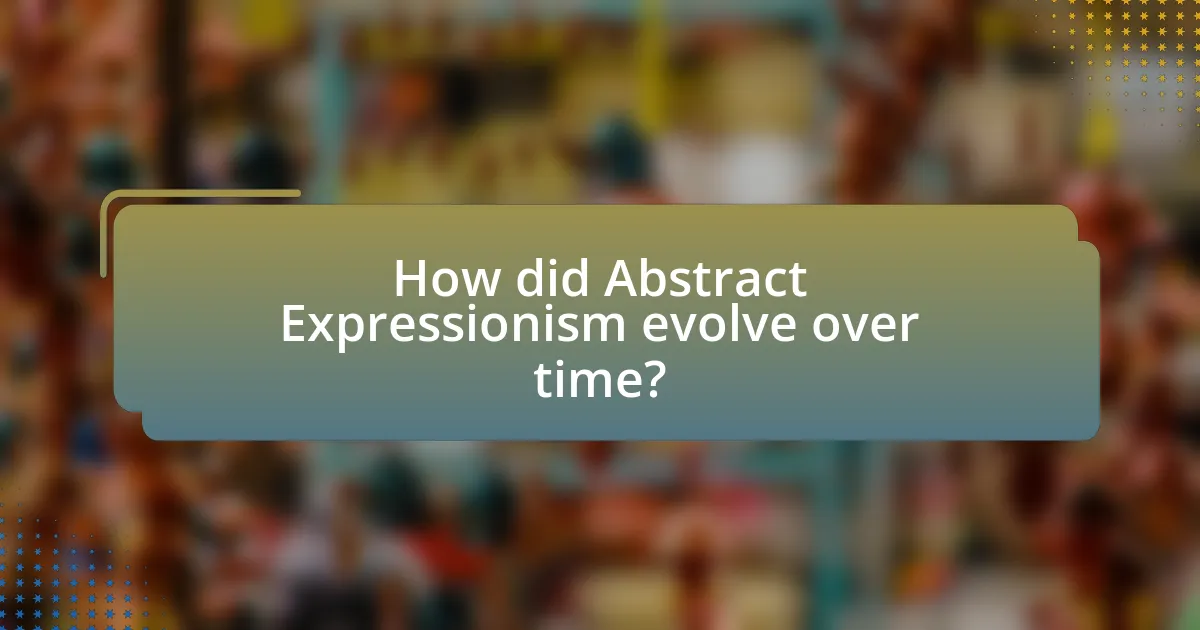
How did Abstract Expressionism evolve over time?
Abstract Expressionism evolved over time through a transition from early influences of Surrealism and Cubism to a distinct movement characterized by spontaneous, gestural painting. Initially, artists like Jackson Pollock and Mark Rothko drew inspiration from European avant-garde movements, but by the late 1940s, they began to develop a unique American style that emphasized individual expression and emotional intensity. This evolution was marked by the shift from representational forms to an emphasis on abstraction, as seen in Pollock’s drip paintings, which exemplified the movement’s focus on the act of painting itself. The movement gained prominence in the 1950s, becoming a dominant force in the art world, particularly in New York, where it was associated with the post-World War II cultural landscape. The rise of Abstract Expressionism was further solidified by exhibitions, such as the 1951 “9th Street Show,” which showcased key artists and their innovative approaches, ultimately establishing the movement as a significant chapter in modern art history.
What were the major shifts in Abstract Expressionism during the 1950s and 1960s?
During the 1950s and 1960s, Abstract Expressionism experienced significant shifts characterized by the emergence of new styles and the diversification of artistic approaches. Notably, artists began to move away from the dominant gestural abstraction of the earlier period, exemplified by figures like Jackson Pollock, towards more varied forms of expression, including color field painting led by artists such as Mark Rothko and Barnett Newman. This transition highlighted a focus on color and spatial relationships rather than solely on dynamic brushwork. Additionally, the incorporation of new materials and techniques, such as the use of acrylic paints and large-scale canvases, further transformed the movement. The shift also included a growing interest in conceptual art and the questioning of traditional artistic boundaries, as seen in the works of artists like Robert Rauschenberg and Jasper Johns, who blurred the lines between painting and other media. These developments collectively marked a pivotal evolution within Abstract Expressionism, reflecting broader cultural and artistic changes of the time.
How did the socio-political climate affect the evolution of Abstract Expressionism?
The socio-political climate significantly influenced the evolution of Abstract Expressionism by shaping the artists’ responses to contemporary events and societal changes. Following World War II, the rise of existentialism and the Cold War context prompted artists to explore themes of individualism, freedom, and the subconscious, reflecting a reaction against the horrors of war and totalitarianism. For instance, artists like Jackson Pollock and Mark Rothko utilized abstraction to express emotional depth and personal experience, which resonated with a society grappling with uncertainty and trauma. The New York School, which included these artists, emerged as a dominant force in the art world, partly due to the migration of European artists fleeing fascism, who brought new ideas and techniques that further evolved the movement. This interplay between socio-political factors and artistic expression underscores how Abstract Expressionism was not only a stylistic development but also a cultural response to the tumultuous environment of its time.
What new techniques and styles emerged from Abstract Expressionism in later years?
New techniques and styles that emerged from Abstract Expressionism in later years include Color Field Painting and Lyrical Abstraction. Color Field Painting, characterized by large expanses of color and minimal detail, was popularized by artists like Mark Rothko and Barnett Newman, who focused on the emotional resonance of color. Lyrical Abstraction, on the other hand, emphasized spontaneity and personal expression, drawing from the gestural techniques of Abstract Expressionism while incorporating more fluid forms and softer colors, as seen in the works of artists like Joan Mitchell and Helen Frankenthaler. These developments reflect a shift towards more varied emotional and aesthetic experiences in the post-Abstract Expressionist landscape.
What is the legacy of Abstract Expressionism today?
The legacy of Abstract Expressionism today is its profound influence on contemporary art, particularly in the realms of abstraction and emotional expression. This movement, which emerged in the mid-20th century, established a foundation for artists to explore personal and subjective experiences through non-representational forms. Its impact is evident in the works of modern artists who continue to prioritize spontaneity, individualism, and the exploration of materials, reflecting the core tenets of Abstract Expressionism. For instance, artists like Mark Rothko and Jackson Pollock have inspired generations, leading to the development of various art movements such as Color Field painting and Action painting, which emphasize the emotional resonance of color and gesture. The ongoing relevance of Abstract Expressionism is also highlighted in contemporary exhibitions and art education, where its principles are taught and celebrated, ensuring its enduring presence in the art world.
How do contemporary artists draw inspiration from Abstract Expressionism?
Contemporary artists draw inspiration from Abstract Expressionism by adopting its emphasis on spontaneity, emotional expression, and the exploration of color and form. This movement, which emerged in the mid-20th century, encourages artists to prioritize personal experience and intuition in their creative processes. For instance, artists like Julie Mehretu and Mark Bradford incorporate gestural brushwork and layered compositions reminiscent of Abstract Expressionist techniques, while also addressing contemporary social and political themes. The influence of Abstract Expressionism is evident in the way these artists utilize large canvases and dynamic forms to evoke emotional responses, reflecting the movement’s foundational principles.
What are the current trends in art that reflect the influence of Abstract Expressionism?
Current trends in art reflecting the influence of Abstract Expressionism include the resurgence of gestural painting, the use of bold colors, and an emphasis on emotional expression. Artists today often adopt spontaneous brushwork and large-scale canvases, reminiscent of the techniques used by Abstract Expressionist pioneers like Jackson Pollock and Mark Rothko. Additionally, contemporary artists are exploring the intersection of abstraction with digital media, creating immersive installations that evoke the same emotional intensity found in traditional Abstract Expressionism. This trend is supported by exhibitions and art fairs that showcase works emphasizing personal narrative and emotional depth, aligning with the core principles of Abstract Expressionism.
What can we learn from the evolution of Abstract Expressionism?
The evolution of Abstract Expressionism teaches us about the shift in artistic focus from representational art to the expression of individual emotion and spontaneity. This movement, which emerged in the 1940s and 1950s, emphasized the act of painting itself as a form of personal expression, as seen in the works of key artists like Jackson Pollock and Mark Rothko. Pollock’s drip paintings exemplify the technique of action painting, where the process became integral to the artwork, reflecting the artist’s emotional state. Rothko’s color field paintings illustrate the use of color to evoke deep emotional responses, demonstrating how abstraction can communicate complex feelings. The movement’s emphasis on individualism and freedom of expression has influenced contemporary art, highlighting the importance of personal narrative and emotional authenticity in artistic practice.
How can understanding Abstract Expressionism enhance our appreciation of modern art?
Understanding Abstract Expressionism enhances our appreciation of modern art by providing insight into the emotional and psychological motivations behind the artwork. This movement, which emerged in the mid-20th century, emphasized spontaneous, automatic, or subconscious creation, allowing viewers to connect with the artists’ inner experiences. For instance, artists like Jackson Pollock and Mark Rothko used color and form to express complex emotions, which invites viewers to engage with the art on a deeper, more personal level. By recognizing the historical context and the artists’ intentions, such as the desire to break away from traditional forms and explore individuality, audiences can better appreciate the innovative techniques and concepts that define modern art today.
What practical insights can artists gain from studying Abstract Expressionism?
Artists can gain practical insights from studying Abstract Expressionism by understanding the importance of emotional expression and spontaneity in their work. This movement emphasizes the act of painting as a means of conveying personal feelings, encouraging artists to prioritize their emotional responses over traditional techniques. For instance, artists like Jackson Pollock utilized techniques such as drip painting to create dynamic compositions that reflect their inner states, demonstrating that the process can be as significant as the final artwork. Additionally, the movement’s focus on abstraction allows artists to explore non-representational forms, fostering creativity and innovation in their own practices. By analyzing the works and methods of key figures in Abstract Expressionism, artists can learn to embrace risk-taking and develop a unique voice that resonates with their personal experiences.










